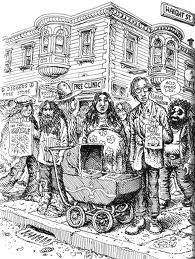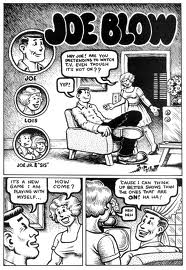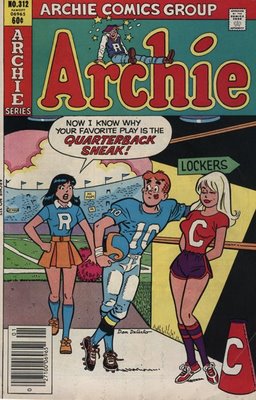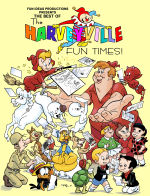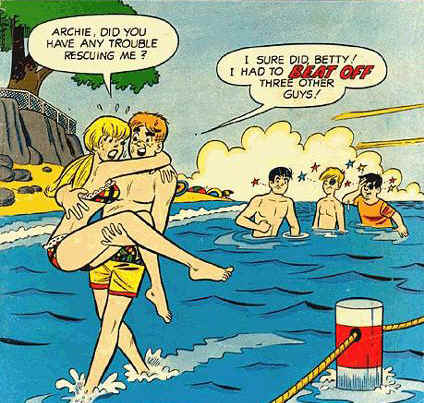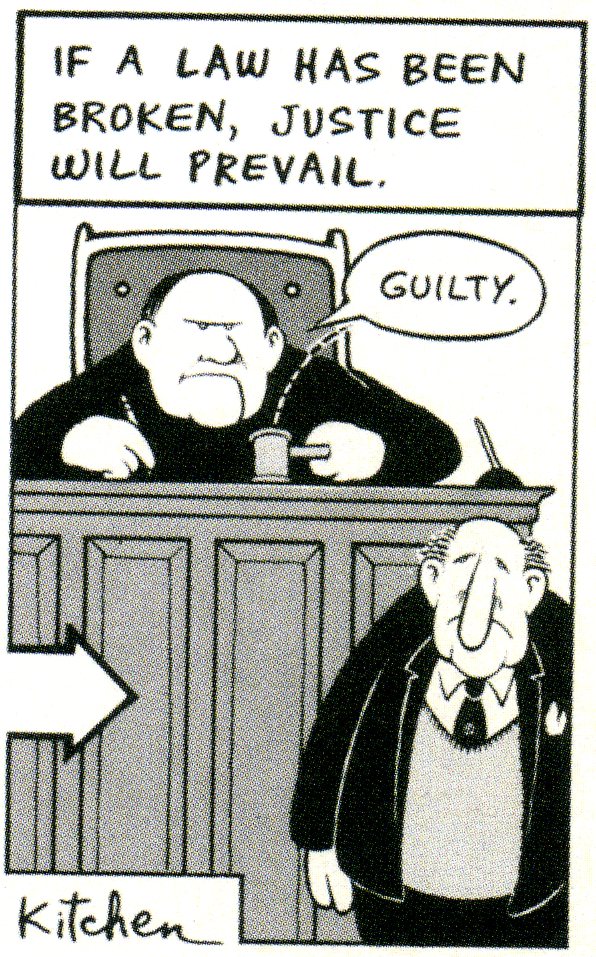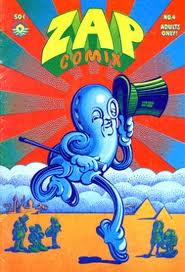 This edition of the obscenity files turns to the world of comics (or rather, comix) to take a look at the arrest and prosecution of two salespeople who sold a Robert Crumb underground comic that featured an all-American incestual orgy to an undercover police officer. This case would not only stall the underground comix movement, but it also inspires today’s generation of creators to be vigilant against attack.
This edition of the obscenity files turns to the world of comics (or rather, comix) to take a look at the arrest and prosecution of two salespeople who sold a Robert Crumb underground comic that featured an all-American incestual orgy to an undercover police officer. This case would not only stall the underground comix movement, but it also inspires today’s generation of creators to be vigilant against attack.
This is a story about a heinous crime. This is the story of People of New York v. Kirkpatrick.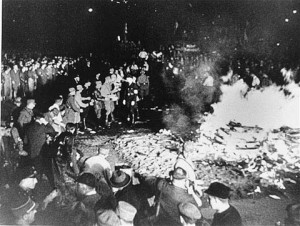
In 1954, the Comics Code Authority instituted a series of industry-wide prohibitions as to what could appear in comic books. In short, the Comics Code stifled artistic creativity in the mainstream comic book industry. In response, several creators, inspired by the horror comics produced by EC that had borne the brunt of the public backlash, started what would be known as the underground comix movement. Underground comix presented a stark, uncensored commentary on society. The books focused on 1960s counterculture subjects like recreational drug use, politics, rock music, and free love. To avoid confusion with the mainstream all-ages books sold in convenience stores and newsstands, the publications were known as “comix.” Of course the “X” also emphasized the frequently X-rated nature of the books. Comix were only available in headshops (i.e., places that sold drug paraphernalia).
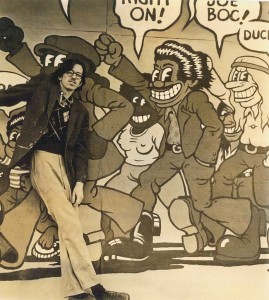 Zap Comix #1 premiered in 1968, coming from the creative mind of Robert Crumb, an underground comix visionary from San Francisco. The book had a false start when the original publisher of the work reportedly left the country with Crumb’s artwork. (Crumb would later use photocopies of the art and release them as Zap Comix #0.) With only 3,500 printed copies (printed by Beat writer Charles Plymell), Zap Comix #1 was released by publisher Don Donahue under the Apex Novelties imprint. In true underground fashion, the first issue was sold in San Francisco’s counterculture headquarters, Haight-Ashbury, out of a baby stroller pushed by Crumb’s wife, Dana. Randy Duncan and Matthew J. Smith, write in Icons of the American Comic Book: From Captain America to Wonder Woman:
Zap Comix #1 premiered in 1968, coming from the creative mind of Robert Crumb, an underground comix visionary from San Francisco. The book had a false start when the original publisher of the work reportedly left the country with Crumb’s artwork. (Crumb would later use photocopies of the art and release them as Zap Comix #0.) With only 3,500 printed copies (printed by Beat writer Charles Plymell), Zap Comix #1 was released by publisher Don Donahue under the Apex Novelties imprint. In true underground fashion, the first issue was sold in San Francisco’s counterculture headquarters, Haight-Ashbury, out of a baby stroller pushed by Crumb’s wife, Dana. Randy Duncan and Matthew J. Smith, write in Icons of the American Comic Book: From Captain America to Wonder Woman:
Zap Comix first began to be sold on the street on February 25, 1968, in the Haight-Ashbury neighborhood by Robert Crumb’s very pregnant wife, Dana, pushing a baby carriage with some copies piled in it. Contrary to a popular myth, Robert Crumb never stood at the corner of Haight and Ashbury, huckstering Zap Comix that day, or ever. Dana was accompanied by Don Donahue and another friend, Marylin “Mimi” Jones McGrew. One of many street fairs was going on that day. They also got some Zaps placed into a few Haight-Ashbury stores, such as In Gear. Selling at 25 cents a copy, the first day sales totaled only $20.50.
Zap Comix #1, labeled “Fair Warning: For Adult Intellectuals Only,” was a big success. And while there were others before it (such as Jack Jackson’s God Nose, Das Kampf, Robert Ronnie Branaman, Bacchanal, The Adventures of Jesus, and Lenny of Laredo), Zap Comix is frequently considered to be the true beginning of the popular underground comix movement. Zap Comix was eventually expanded to include to several other artists, including S. Clay Wilson, Robert Williams, “Spain” Rodriguez, Gilbert Shelton, and two artists with reputations as psychedelic poster designers, Victor Moscoso and Rick Griffin.
Despite the growing popularity of Zap Comics aand limited distribution, there was an ongoing attack against underground comix. As Mark James Estren describes in A History of Underground Comics:
Some local authorities have decided that the underground comics are indeed the threat to puritanical American values which the cartoonists want them to be. . . . this decision has led some of them to attempt obscenity busts involving the underground comics. . . . these arrests have hit at the distributors and dealers of the comics, this being the most efficient way of preventing the material from reaching the public. Moe’s Bookstore in Berkeley was busted for selling Snatch Comics and Zap Comix. The Phoenix Gallery (also in Berkeley), after developing an art show featuring the work of numerous underground cartoonists, was busted for displaying obscene materials. In Encino, California, an employee of the Third Eye bookstore was arrested for selling Zap Comix No. 2. And so on, and on, and on and on.
In almost every case, the obscenity busts have come to nothing. In the Third Eye bookstore case, a judge in Division 21 of the county court ruled that the strip which allegedly made Zap No.2 obscene . . . was not obscene because it did not arouse one’s prurient interests.
Despite the attempts to shutdown underground comix, the success of Zap Comix continued. But with issue #4, released in August 1969, the book would become infamous. That was because of a story by Crumb called “Joe Blow” that attacked social conventions. “Joe Blow” was drawn in a simple, Walt Disney style and featured a white-collar executive who, after a hard day at the office, enjoyed spending quality time with his nuclear family. Of course, this quality time consisted of an incestual orgy (with the motto “the family that lays together, stays together”), thus providing a unique commentary on the hypocrisy of America. Almost immediately, Zap Comix #4 was targeted by a law enforcement in effort to remove it from circulation. There were a series of arrests on the West Coast, but the charges were quickly dropped.
 On the East Coast, Zap Comix #4 was the subject of a sting operation by the so-called Morals Squad in New York. On August 25, 1969, Patrolman Megna, an undercover policeman from the Morals Squad, walked by the East Side Bookstore and saw a showcase in front of the sales counter with copies of Zap Comix #4. In trial, Megna testified that he bought a copy from Terrence McCoy for 50 cents. On August 25 and again on September 17, 1969, Officer Megna made similar purchases from Peter Kirkpatrick, a 23-year-old bookshop manager who was behind the counter at the New Yorker Bookstore. Also on September 17, Menga purchased a copy of the Zap Comix #4 from Peter Dargis at the East Side Bookstore and “observed numerous copies” of that magazine in a glass case.
On the East Coast, Zap Comix #4 was the subject of a sting operation by the so-called Morals Squad in New York. On August 25, 1969, Patrolman Megna, an undercover policeman from the Morals Squad, walked by the East Side Bookstore and saw a showcase in front of the sales counter with copies of Zap Comix #4. In trial, Megna testified that he bought a copy from Terrence McCoy for 50 cents. On August 25 and again on September 17, 1969, Officer Megna made similar purchases from Peter Kirkpatrick, a 23-year-old bookshop manager who was behind the counter at the New Yorker Bookstore. Also on September 17, Menga purchased a copy of the Zap Comix #4 from Peter Dargis at the East Side Bookstore and “observed numerous copies” of that magazine in a glass case.
Megna personally arrested McCoy. Kirkpatrick was arrested for “promoting obscenity.” Across town, Peter Dargis, manager of East Side Bookstore was also arrested for selling Zap Comix #4. The police also arrested the owner of the New Yorker Book Store, Pete Martin and the owner of the East Side Bookstore, James Rose but the charges against Martin and Rose were dropped.
 The case was assigned to Judge Joel Tyler, former Commissioner of Licenses who previously issued the ruling that labelled the movie Deep Throat obscene (thus, making it famous). The people of New York were represented by Manhattan Assistant District Attorney
The case was assigned to Judge Joel Tyler, former Commissioner of Licenses who previously issued the ruling that labelled the movie Deep Throat obscene (thus, making it famous). The people of New York were represented by Manhattan Assistant District Attorney  Richard Beckler, who had a unique trial strategy. As the Court stated, “The People introduced no evidence, whatsoever, as to the character or contents of Zap No. 4, but merely urged the court that its examination would reveal that the material contained therein is obscene ‘as a matter of law.'” Basically, Beckler simply provided the Court with a copy of Zap Comix #4 and asked for it to be found obscene. Under New York law at the time, “A person who promotes obscene material, or possesses the same with intent to promote it in the course of his business, is presumed to do so with knowledge of its content and character.” Thus, any ruling that Zap Comix #4 was obscene as a matter of law would have the effect of shifting the burden of proof back to the accused to prove that they did not know the book was obscene when it was sold it to the undercover police officer.
Richard Beckler, who had a unique trial strategy. As the Court stated, “The People introduced no evidence, whatsoever, as to the character or contents of Zap No. 4, but merely urged the court that its examination would reveal that the material contained therein is obscene ‘as a matter of law.'” Basically, Beckler simply provided the Court with a copy of Zap Comix #4 and asked for it to be found obscene. Under New York law at the time, “A person who promotes obscene material, or possesses the same with intent to promote it in the course of his business, is presumed to do so with knowledge of its content and character.” Thus, any ruling that Zap Comix #4 was obscene as a matter of law would have the effect of shifting the burden of proof back to the accused to prove that they did not know the book was obscene when it was sold it to the undercover police officer.
At trial, Kirkpatrick and Dargis were represented by Robert Levine and Stephen Rohde, who argued that Zap Comics #4 had redeeming social value and thus could not be declared obscene under the law. To prove its case, the defense relied on the testimony of four expert witnesses. First, Gil Kane, a mainstream DC Comics artist, expressed his admiration of Crumb and compared his work to that of an expressionist painter. Second, Robert M. Doty, curator of New York’s Whitney Museum of American Art, testified that he displayed Crumb’s art at the Whitney Museum’s exhibit, “Human Concern and Personal Torment: The Grotesque in American Art.” Third, Steven Marks, a teacher and writer, stated that he regularly used Crumb’s strips in his humanities course at Columbia University. Fourth, Sidney Jacobson, an editor at children’s publisher Harvey Publications, argued that underground comix should be respected as a medium to express adult stories and adult situations. (I should add that during trial, Judge Tyler admitted to regularly reading Harvey Comics and took issue with the fact that Jacobson said they were intended for the lowest age group.)
During examination of Jacobson (reproduced in the Estren book), Judge Tyler revealed his views on the case when the subject of Archie Comics came up:
A (by Jacobson): I certainly think that Archie is certainly a little sexy comic book.
Q (by Mr. Levine): Archie is supposed to be a child’s comic?
A: Yes.
Q: You think that it is sexual?
A: I know.
Judge Tyler: You know? Is there more than one Archie?
A: Archie Comics, which would be Archie and who — the teenage character.
Judge Tyler: But there is just one Archie that you mentioned is that so?
A: I’m sorry–
Judge Tyler: You mean a magazine? Is there any other comic book called Archie?
A: No, there is the famous one that’s about twenty years old that has been successfully going.
Judge Tyler: You are talking about that, Mr. Jacobson, only one?
A: As far as I know.
Judge Tyler: You say that deals in sexuality
A: Absolutely.
Judge Tyler: Tell me in what way.
A: What way?
Judge Tyler: Yes.
A: Purposely written and drawn to arouse sexualities in teenagers. I think this is done without question.
Q (by Mr. Beckler): What do you mean by “sexuality” in Archie?
A: I mean by that the publishers, the editors and writers are putting in — the people involved in drawing and creating Archie are trying within it to appeal to the sexual desires of their public, which is a little different.
Q: Would you say arousing the prurient interest?
A: No, I wouldn’t say that. I would say arousing the sexual interest.
Q: Would you say that Zap No.4 arouses sexual interest?
A: No, not really.
Q: So, it would seem to me, on the sliding scale of yours, that Archie would arouse more interest of the sex appeal than Zap No.4, is that correct?
A: Yes, to its reader.
Judge Tyler: How about Archie? Is that obscene?
A: No, I don’t think it’s obscene, I think it’s sexual.
Judge Tyler: Do they intend in Archie to appeal to the sexuality of the teenager?
A: Yes, they do.
Judge Tyler: Do you deem that an obscene purpose?
A: No, I don’t.
The Court also heard from several fact witnesses.
First, Patrolman Megna testified about the purchases and the arrests.
McCoy took the stand and denied that he was in the bookstore on August 25, 1969, or that he sold the copy to Patrolman Megna. The Court also took notice that McCoy had long straight hair and is 5 feet 8½ inches tall, in contradiction to the arrest warrant, which describes the person who sold Zap #4 to Officer Megna as having curly hair and being 6 feet 1 inch tall. McCoy testified that the warrant described Bob Gillespie, another employee. A “day sheet,” was put into evidence, showing those employees working each day that stated McCoy did not work that day.
Dargis testified that while he ordered 200 copies of Zap #4, he had never read or discussed the comic. He remembered unpacking the book and looking at the cover, which was clearly labeled “Adults Only.” He also testified that underground comix represented less than 1% of the gross sales of the East Side Bookstore. Finally, he confirmed that McCoy did not work on August 25.
Kirkpatrick testified that he performed the office work, billing invoices, accounting, reorders, and sold in the store and that he had personally sold 25 to 30 copies of Zap #4. Kirkpatrick also said that had never read Zap Comix #4, and he confirmed that, like the East Side Bookstore, the sales from underground comix represented less than a fraction of 1% of total sales.
The Court issued its opinion on October 28, 1970. First, the court acquitted McCoy based on the testimony that the arrest warrant describes the seller as one having physical characteristics substantially different than that of McCoy; that the records of the bookshop indicate, and its manager testified, that McCoy was not working on the day of the sale, and McCoy’s own denial of his presence and of the sale, created reasonable doubt.
However, the Court found Kirkpatrick and Dargis guilty as charged beyond a reasonable doubt. The Court found Zap Comix #4 was obscene as a matter of law and concluded:
It is material utterly unredeemed and unredeemable, save, perhaps, only by the quality of the paper upon which it is printed. It is patently offensive. It has gone substantially beyond “the present critical point in the compromise between candor and shame at which the community may have arrived here and now” It is a part of the underworld press — the growing world of deceit in sex and it is not reality or honesty, as they often claim it to be. It represents an emotional incapacity to view sex as a basis for establishing genuine human relationships, or as a normal part of human condition. It is what Dr. Benjamin Spock characterizes as “shock-obscenity,” representing a brutalizing trend in our society. The development of understanding of, or making proper comment about, sex is vitiated by its graphic and venal exploitation of sexuality. And such exploitation is an unfortunate concomitant of our times. Zap No. 4 is an exploiter; its effect is to purvey “filth for filth’s sake.” It is hard-core pornography. Perhaps that type of obscenity contains its own antidote and eventually becomes a repetitious bore — but, unfortunately by that time it has rendered its victims shock-proof, jaded and permissive to the point of indifference toward moral values and tolerable behavior. The material must fail by any legal test yet announced, including [the New York obscenity law], and stands condemned as a violator of that law. The magazine is legally obscene.
The Court also ruled that that the presumption that the defendants “knew” the material they were selling was obscene was valid. The court stated:
I disagree that the defendants cannot be presumed, to know, in general, the contents and character of the material they offer to sell and sell. . . . It is “based on life and life’s experience” to expect merchants to know something about the items they sell in their business, without expecting them to have examined each carefully. Is it farfetched, as defendants maintain, to presume that a bookseller or magazine vendor who sells obscene material in the course of his business knows something of its contents and character? I believe not, and to maintain such a position is to divorce oneself from the realities of “life’s experience.” “No corner hardware merchant would long prosper,” remarks Richard H. Kuh in his interesting book (Foolish Fig Leaves? Pornography In-And-Out-of-Court, 1967, p. 264) “lacking general familiarity with the items he had for sale. No Wall Street broker could succeed, ignorant of fluctuations in the securities he marketed. Similarly, honest book and magazine dealers have some general knowledge of the character of the wares they order, put on their shelves, sometimes display, and ultimately hope to sell.” . . . . It is not unreasonable for the law to presume that the bookseller knows his merchandise, since to expect less would, as Mr. Justice FELIX FRANKFURTER noted, permit the bookseller to insulate “himself against knowledge about an offending book” and “thereby free to maintain an emporium for smut.”
Nor, does this presumption create an unreasonable hardship upon defendants. The presumption is not conclusive; “it gives him every opportunity to rebut the presumption * * * merely calling upon him to explain * * *. And even if he offers no explanation, the jury may still refuse to convict. The burden of proof upon the entire case, the duty of establishing guilt beyond a reasonable doubt, remains as ever with the prosecution. Defendants’ right to a fair trial continues undiminished; no hardship is imposed, no constitutional right or safeguard impaired.” . . . .
[The New York Statute] raises no presumption of knowledge, by mere possession of obscene material. The presumption is operable only if the material is actually sold (lent, delivered, etc.) in “the course of his business,” or if possessed with intent to sell (lend, deliver, etc.) “in the course of his business” . . . . . Accordingly, our presumption cannot operate against a private individual who sells or lends or delivers, etc. an obscene book to another, unless he does so “in the course of his business,” nor can it operate against a retailer who does not sell or intend to sell an obscene item in the course of his business. [The New York Statute] was intended to raise presumptions against those in the business of regularly dealing in obscene material, either in large or small quantity, and as to them, there is a rationality and logic to the expectation that those who sell or intend to sell such material in the course of their business, know something of the character of the contents thereof.
In reaching the conclusion that the book was obscene, the Court rejected the opinions of the experts:
I find that all of these witnesses failed to particularize in understandable lay terms their generalizations that the cartoonists were “original,” or how they were “influencing a new generation of cartoonists” or how they showed “enormous vitality” or where was the satire or parody of the sexual experiences depicted; or why was the explicit sexuality, as demonstrated, necessary to the theme (i.e., a commentary on conventional relationships in middle-class society); or how do these cartoons, dealing as they do in the main with perverted sexual experiences, attempt to “humorously outrage” the reader and place in perspective human values.
Instead, the Court substituted its own view:
In the final analysis, the Court must be the expert in assessing what is the dominant theme, prurient interest, community standards, any redeeming social value, and the like…. Merely because the magazine in question does not appeal to the prurient interest of the sophisticated or other small group of intellectuals does not remove it from the prohibition [against obscenity]. To do so would permit the substitution of defendants’ sophisticated and intellectual experts for those of the average person in the contemporary community.
Kirkpatrick and Dargis were fined $500, and if the fine was not paid, ordered to serve 90 days in jail. The fines were paid.
After the decision, the owner of the New Yorker Bookstore, Pete Martin was incensed and told the Village Voice that he would help his employe appeal the conviction. He stated:
The city is being hypocritical. They don’t want to look like censors, so they try to make us censor ourselves. They never informed us that Crumb is obscene. They should have arrested me as the owner of the store. Charles is a Vietnam veteran with no record. Now he has one. He’s been mugged and fingerprinted, and if he ever applies for a fellowship or something, this will be held against him, just because he sold a comic book. And the city never busts big chains like Bookmasters. They sell Crumb, too. Only small, independent stores like us and the East Side Bookstore on St. Mark’s Place get busted.
Before discussing the appeal, I should note that when Judge Tyler retired, he said, referring to the Deep Throat decision, “If I were to write that appendix today, I would be deemed a fool, given the substantial change in our outlook.” Given the recognition of Crumb, Pekar, and many other underground creators, I think he would agree that the statement would equally apply to the Zap Comix decision. Judge Tyler died in January 2012 at the age of 90.
After paying the fine, Kirkpatrick and Dargis appealed. The Appellate Term affirmed the lower court’s decision, so they again appealed by leave of an Associate Judge of the New York Court of Appeals, the highest state court level in New York. The Court of Appeals affirmed with a 4-3 decision. The majority concluded:
The fact of obscenity need not be dwelt upon at this time. Most of this court agrees with the courts below that the material sold was obscene, and its nature was discussed by the trial court in its elaborate opinion determining the case. What remains at issue, with disagreement in this court, is whether the record contained sufficient evidence to establish that the booksellers knew of the obscene contents and by way of alternative ratio decidendi whether the statutory presumption that a seller of obscene materials knows the contents of what he sells is valid.
The majority relied on the trial courts findings to determine that:
The trial court both found actual knowledge and applied the statutory presumption. . . . . It is evident then that the trial court found scienter [knowledge of wrongdoing] both by reason of the statutory presumption not having been rebutted and by its own inference of the fact of knowledge from the evidence. Since the attack on the validity of the presumption rests in part on the probabilities of knowledge by the booksellers of what kind of material they were selling, it necessarily follows that the probabilities supporting the validity of the presumption, the failure to rebut it successfully, and the inference of knowledge overlap. The conviction should be affirmed on either view of the case.
The majority then addressed First Amendment concerns raised by the presumption that the defendants knew what they were selling was obscene:
Notably, the [Supreme Court] recognized that any obscenity statute applicable to a bookseller will induce some tendency to self-censorship, but also indicated that the decision did not require meeting the problem. The importance of the expressed restraint is of course that otherwise any effective control of obscenity would become impossible. The “hardcore” obscenity to which modern efforts are directed is largely of the kind where the authors and publishers are or would be largely anonymous or disguised. It is at some point of distribution that the offense may be uncovered and only sometimes worked backward to the makers of the contraband. In any event, so long as the Supreme Court has not viewed obscenity as beyond legislative control, it behooves the courts to sustain rational efforts at control and not, indirectly on attenuated constitutional speculations, to overthrow serially every restrained effort at control. So long as obscenity measures are restricted to the type of material now involved, the social redeeming value qualification retained, and only rebuttable presumptions based on rational connection or probabilities are utilized, the risk to constitutionally protected speech or press is invisible.
In short, the majority upheld the constitutionality of a statutory presumption that the seller of obscene materials knows the contents of that material and also held that there was sufficient independent evidence of scienter to support the conviction.
The dissent disagreed. First, the dissenters did not agree that the trial court found actual knowledge of the contents of the magazine. Chief Judge Fuld, writing for the dissent, stated:
Despite the indisputable fact that there was not a word of testimony or evidence presented during the People’s case that either defendant knew the content or nature of Zap No. 4, the trial judge, after the prosecution rested, reserved decision on the defense motion to dismiss on the ground that evidence of scienter was lacking. This ruling demonstrates that the judge necessarily relied on the statutory presumption of knowledge; had he not done so, he would, of course, have granted the motion. In any event, after decision on their motion had been reserved, the defendants took the stand quite obviously to attempt to rebut that presumption. . . .
In short, implicit both in the court’s conduct of the trial and in its treatment of the case is a determination that, absent reliance upon the presumption, the proof offered did not establish that the defendants knew the allegedly obscene nature of the material. This being so, our court may not make a new finding of fact even though we were to assume that the trial judge could have made such a finding.
Turning to the presumption, the dissent stated:
A statutory presumption violates due process, the Supreme Court has held, if there is “no rational connection between the fact proved and the ultimate fact presumed, if the inference of the one from proof of the other is arbitrary because of lack of connection between the two in common experience. * * * [W]here the inference is so strained as not to have a reasonable relation to the circumstances of life as we know them, it is not competent for the legislature to create it” . . . . It is most unlikely that a bookseller — especially in a store such as those in which the defendants were employed — would have knowledge of the content of the publications being offered for sale. . . . Reason and experience tell us that it would be impossible for a bookseller in either store to acquaint himself with the content and character of so large a number of titles. In any event, it may not be said with “substantial assurance” — as required by the cases — that such booksellers may be “presumed” to know the content and character of a publication merely upon proof that they sold it.
However, even if the statutory presumption were able to withstand an attack based on due process grounds, I would be impelled to stamp it unconstitutional as an infringement on the freedom of expression guaranteed by the First Amendment. The presumption violates that amendment because it creates and occasions a system of “self-censorship” on the part of booksellers which affects the sale and distribution of all books — those that are constitutionally protected as well as those that are obscene. . . “By dispensing with any requirement of knowledge of the contents of the book on the part of the seller, the ordinance tends to impose a severe limitation on the public’s access to constitutionally protected matter. For if the bookseller is criminally liable without knowledge of the contents, and the ordinance fulfills its purpose, he will tend to restrict the books he sells to those he has inspected; and thus the State will have imposed a restriction upon the distribution of constitutionally protected as well as obscene literature. * * * And the bookseller’s burden would become the public’s burden, for by restricting him the public’s access to reading matter would be restricted. If the contents of bookshops and periodical stands were restricted to material of which their proprietors had made an inspection, they might be depleted indeed. The bookseller’s limitation in the amount of reading material with which he could familiarize himself, and his timidity in the face of his absolute criminal liability, thus would tend to restrict the public’s access to forms of the printed word which the State could not constitutionally suppress directly. The bookseller’s self-censorship, compelled by the State, would be a censorship affecting the whole public, hardly less virulent for being privately administered. Through it, the distribution of all books, both obscene and not obscene, would be impeded.” . . . .
Although the State may generally regulate the allocation of the burden of proof through legislation, it is clear that a statute may not, where the First Amendment is involved, declare a person presumptively guilty of a crime or presume that he has committed one of its material elements. Freedom of speech is too important a right to allow it to be seriously impeded or impaired by a presumption.
After yet another loss, Kirkpatrick and Dargis applied to the Supreme Court for a writ of certiorari. The Supreme Court dismissed the petition for want of substantial federal question without opinion. More interesting, however, were the dissents.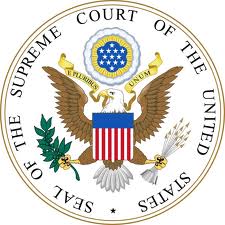
Justice Douglas wrote that he was “of the view that state obscenity regulation is prohibited by the Fourteenth and First Amendments” and noted that he would rule there was “probable jurisdiction in this case and reverse judgment of conviction.” Justice Brennan (joined by Justices Stewart and Marshall) wrote that:
It is my view that “at least in the absence of distribution to juveniles or obtrusive exposure to unconsenting adults, the First and Fourteenth Amendments prohibit the State and Federal Governments from attempting wholly to suppress sexually oriented materials on the basis of their allegedly “obscene” contents.” Since it is clear that, when tested by that constitutional standard, the word “obscene” in [the New York Law], renders [the statute] unconstitutionally overbroad and therefore facially invalid, I disagree with the holding that the appeal does not present a substantial federal question, and therefore dissent from the Court’s dismissal of the appeal.
Of course, the effect of the Supreme Court’s action in Kirkpatrick has been hotly debated. This dismissal, in its procedural context, was equivalent to an adjudication of the federal issue on its merits. However, many courts that have found the dismissal of the appeal in Kirkpatrick ambiguous or inconclusive on the issue of the constitutionality of the presumption challenged.
Despite the legal effect of the decision, the damage to underground comix was done. As Jean-Paul Gabilliet explains in Of Comics and Men: A Cultural History of American Comic Books:
On September 17, 1969, in New York, the owner of the New Yorker Book Store and his employee Charles Kirkpatrick were arrested for offering “obscene” publications for sale, specifically Zap Comix #4. One year later, Kirkpatrick and Peter Dargis, the vendor at East Side Book Store, were convicted of selling obscene material in the form of the very same comic book. Immediately, this judgment became precedent and transformed everyone who sold underground comics into targets for the authorities. It simultaneously dissuaded publishers and bookstores from lodging complaints based on the First Amendment. Through an irony in the system, the head shops that gave in to this intimidation and ceased to sell comix and other publication deemed obscene could continue to sell the necessary material for drug consumption without bother.
The same conclusion was reached by Paul Lopes in his book, Demanding Respect: The Evolution of the American Comic Book:
By 1973, underground artists saw their ideology based on the belief in autonomous self-expression and the view of comic art as more than just commercial product confirmed in the booming underground market. Unfortunately that same year the underground market crashed as a number of factors undermined what seemed like an all unstoppable boom. The first major factor was the suppression of underground comix through government censorship. The general breaking of previous boundaries on sexually explicit material accompanying the counterculture rumblings of the 1960s reignited general fears of a rising demand for obscenity in the United States. Underground comix quickly led to authorities seizing comix and busting individuals involved in selling or publishing comix. But according Mark Estren., few led to actual convictions. Only two salesmen in New York City, Charles Kirkpatrick and Peter Dargis, were convicted for selling comix. The general debate around obscenity, however led to the U.S. Supreme Court to reconsider its stand on state censorship and obscenity. In a landmark case, the Supreme Court in 1973 introduced the “community standard” doctrine, whereby local communities were given greater power to decide what was obscene and what was not obscene. This significantly empowered local authorities fighting against obscene material and dealt a terrible blow to the underground comix market.
Of course, Duncan and Smith explain that, despite this heightened scrutiny, Zap Comix still survived:
In early 1969 Zap Comix #4 appeared, containing a story called “Joe Blow,” a satire on the nuclear family that contained multiple and graphically depicted acts of incest and was meant to push the boundaries of the law. It pushed too far, and many retailers were busted for obscenity for stocking the offensive material. The most infamous case involving Zap #4 was People v. Kirkpatrick (1970), which went to the Court of Appeals of the State of New York. . . .
Even as artists and fans were celebrating their art form at Berkeleycon, the storm clouds were gathering. In some ways, 1973 was the beginning of the end for the underground comix movement. Just a month before Berkeleycon, the New York Court of Appeals upheld the obscenity conviction of Charles Kirkpatrick for selling Zap #4. This encouraged more vigorous prosecution of head shops and record stores selling underground comix. . . . Despite the efforts to crack down on underground comix, Zap continued publication. . . . After issue #6, Zap appeared more infrequently, yearly for a time and then with years between Issues. Zap #15 in 2005 is the most recent issue published.
The current state of the issue has been summarized by James McWilliams, a contributing writer for the First Amendment Center.
Now, more than 30 years after the Kirkpatrick case, Zap No. 4 has been sold in New York City with no criminal repercussions, according to David Jay Gabriel, executive director of the New York City Comic Book Museum. The artists behind the comic have claimed that it critiques serious sexual and cultural issues, and much of the national reading public has apparently rendered a de facto verdict that Zap No. 4 and similar books — although often gruesome — do have serious value in debates on those issues. That de facto verdict has come in the form of exhibits at the Museum of Modern Art displaying the work of Zap No. 4 artists, the heaping of critical acclaim on a 1990s movie biography of Robert Crumb, and the open buying and selling of hardcover editions of “underground comix” at major bookstores like Borders and Barnes & Noble nationwide. Perhaps some contemporary readers have taken note of the fact that many sexual images that drew the wrath of public officials generations ago are now considered classic art: for instance, Michelangelo’s nudes in the Sistine Chapel and Rembrandt’s frank drawings of himself having sex with his wife and of her urinating outdoors.
It is interesting to note as mentioned out in my previous column on government comics that:
[I]n 1975, Denis Kitchen, Peter Loft, and Poplaski produced Consumer Comix for the Wisconsin Department of Justice. The title deliberately had the look and feel of the underground comix movement. This was six years after the 1969 raids involving Zap Comix.
This panel from the book unintentionally foreshadowed the fate for a lot of underground comix:
 Of course, the Kirkpatrick decision is a tragedy, but it is also stands as stark reminder as to why comic creators and dealers must remain vigilant. In a recent NY Comics & Picture Story Symposium, Charles Brownstein, Executive Director of the Comic Book Legal Defense Fund presented “The Trial of Zap Comix: Comics, Counterculture & Obscenity in NYC.” In it, Brownstein discussed the case and how it negatively impacted comics for decades. However, things would hopefully be different if this case were to arise today, in part because of the work done by CBLDF. Brownstein stated, “The [CBLDF] matters because comics matter, the people who make them matter, and the people who read them matter. There’s still a double standard that comics aren’t entitled to the same rights as other media, and that’s simply not the case. And as long as we’re here it never will be.”
Of course, the Kirkpatrick decision is a tragedy, but it is also stands as stark reminder as to why comic creators and dealers must remain vigilant. In a recent NY Comics & Picture Story Symposium, Charles Brownstein, Executive Director of the Comic Book Legal Defense Fund presented “The Trial of Zap Comix: Comics, Counterculture & Obscenity in NYC.” In it, Brownstein discussed the case and how it negatively impacted comics for decades. However, things would hopefully be different if this case were to arise today, in part because of the work done by CBLDF. Brownstein stated, “The [CBLDF] matters because comics matter, the people who make them matter, and the people who read them matter. There’s still a double standard that comics aren’t entitled to the same rights as other media, and that’s simply not the case. And as long as we’re here it never will be.”
Joe Sergi is a life-long comics fan and author who has written short stories, novels, comics, and articles in the horror, science fiction, super hero, and young adult genres. He most recent books are the graphic novel Great Zombies in History from McFarland Press and the young adult novel Sky Girl and the Superheroic Adventures from Martin Sister Publishing. When not writing, he works as a Senior Litigation Counsel in an unnamed US government agency. More information can be found at http://www.joesergi.net.
